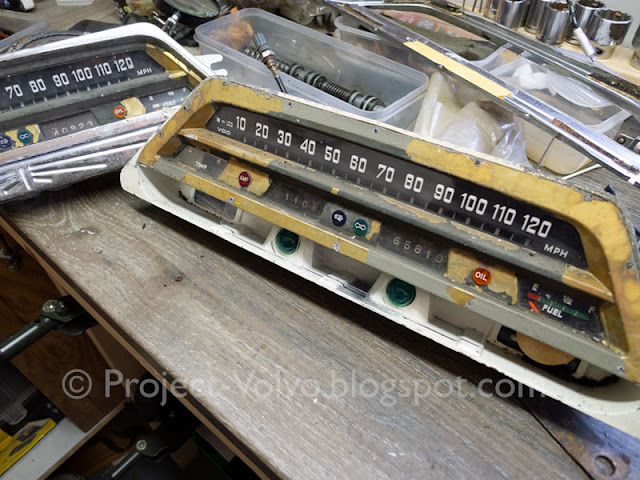They are fixed originally by being melted from the back. They also each have a rubber shroud which being 50+ years old and subjected to heat cycles from the lamps, are somewhat discoloured and cracked. I don't think that there is a hope in hell of new/replacement ones being available, so it is important to salvage these. Although not glued to the facia, two had stuck to it.
I didn't want to just pull at them as they would quite probably split. Instead, I applied a small dab of acetone with a brush and gradually eased them off.
I then used a craft knife to carefully remove the melted edges of the plastic lens, as little off as possible to allow the lens to be pressed through. If you are trying this yourself, be patient and nibble away gently.
With all the shrouds and lenses removed, the facial was prepared for paint by scouring with an emery cloth and a wipe over with panel wipe.
The paint that I selected is 'VHT Wrinkle Plus'. This is a heat resistant paint designed for rocker covers and other under-bonnet items, as well as dashboards.
I watched a few YouTube reviews and demonstrations, then I gave it a try. I followed the recommended method: a light mist coat, then a thick coat working horizontally, followed by a vertical coat and then a final pass laying the paint down diagonally.
In order to achieve the crackle finish, heat is required. The manufacturer's instructions recommend baking in an oven, but as others have suggested I simply used a heat gun. As the heat is applied and the paint begins to cure, the crackle effect can clearly be seen. The piece then needs to be left for at least 24 hours to completely cure/harden.
A couple of days later, I reassembled the speedometer. My original plan was to superglue the lenses to the facia piece, but I found that there was sufficient excess of plastic remaining to allow me to 're-melt' the plastic rim, using a soldering iron. I was also able to use the same technique to reattach the facia to the perspex.
I must say that I am extremely impressed with this outcome. The crackle finish looks a very close approximation of the original factory finish and although it might not be the exact same shade, I suspect that only a direct side by side comparison would reveal any difference. This refurbishment process is a little fiddly, requiring patience and finesse. If you are considering a similar makeover on your Volvo speedometer, it would of course involve removing it from the dash which you might consider too much trouble. But if it's already out, go for it.













Comments
Post a Comment